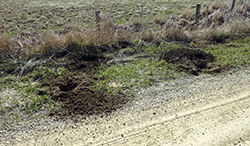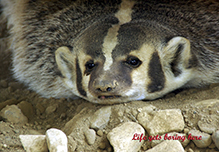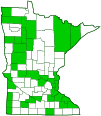American badger
(Taxidea taxus)
Conservation • Description • Habitat • Ecology • Distribution • Taxonomy
Conservation Status |
|||
| IUCN Red List | LC - Least Concern |
||
| NatureServe | N5 - Secure SNR - Unranked |
||
| Minnesota | not listed Species in Greatest Conservation Need |
||
Description
American badger is a solitary, medium-sized, common but seldom seen, carnivorous mammal. They are 28″ to 34″ in length, including the tail, and weigh 11½ to 24¾ pounds. Males are significantly larger than females. Badgers rarely live more than 4 or 5 years in the wild, but may live 10 years or more in captivity.
The body is stocky, low to the ground, and somewhat flattened. The fur (pelage) on the upper parts is yellowish-gray to reddish-brown and long, especially long at the sides. The longer hairs (guard hairs) are banded, giving the pelage a grizzled appearance. A bold, white, upper-middle (middorsal) stripe runs from the nose, over the top of its head, and ends on the nape of the neck near the shoulders. It does not extend onto the back. The underparts are buffy. The belly is whitish. The tail is short, 4¼″ to 7½″ long, and bushy.
The head is broad, especially at the back. The neck, crown, and nose are dark brown or black. The cheeks are white with a large black spot in front of each ear. The chin and throat are whitish. The ears are low and are edged with white.
The legs are short and stocky. The feet are dark brown or black. The claws on the front feet are extremely long.
Common badger (Taxidea taxus taxus) is the largest of the four subspecies.
Jackson’s badger (Taxidea taxus jacksoni) is typically darker and smaller, 23½″to 29½″ in length and weighing 15½ to 24¼ pounds.
Size
Total length: 28″ to 34″
Tail: 4¼″ to 7½″
Weight: 11½″ to 24¾″ pounds
Sign
Similar Species
The low, flattish profile and white middorsal head stripe are diagnostic. There are no similar species in North America.
Habitat
Badgers are animals of open places, including meadows, prairies, pastures, croplands, and brushlands with little or no ground cover. Their spread into forested regions has closely followed the clearing of those forests to create pastures and cropland.
Ecology
Behavior
Badgers are active mostly at night but also often during the day, especially in early morning. They are solitary animals.
Badgers are good diggers. They are the only mammal that can dig out pocket gophers. They usually dig their own burrow but may enlarge one dug by another mammal. They spend the day, raise their young, and spend the winter in a burrow. The burrow may be up to 26′ long and up to 6¾′ deep.
Adults have a home range of usually about 1 square mile in which they may have up to 46 burrows. In the winter their home range is much smaller. They are mostly inactive in winter, emerging occasionally on warmer days. They do not hibernate but may enter into a temporary state of reduced metabolic activity (torpor) lasting several days to several weeks.
Lifespan
4 to 5 years
Life Cycle
Mating takes place in August and September. The female then digs a nest at the end of its burrow and lines it with grass. The developing fertilized eggs (blastocysts) do not implant in the uterus until February or March. A litter of 1 to 7, usually 3 or 4, is born in March to early April. The female cares for the young until late summer or early fall.
Food
Mostly ground squirrels and pocket gophers, but also voles, mice, reptiles (including rattlesnakes), amphibians, ground-nesting birds and their eggs, insects, and other invertebrates.
Distribution |
||
|
Sources Biodiversity occurrence data published by: Minnesota Biodiversity Atlas (accessed through the Minnesota Biodiversity Atlas Portal, bellatlas.umn.edu, 12/5/2025). Hazard, Evan B. 1982. The Mammals of Minnesota. University of Minnesota Press, Minneapolis, Minnesota. 280 pp. The counties in light green lack modern records but have historic county or township specimens or records. |
|
| 12/5/2025 | ||
Central North American badger (Taxidea taxus taxus) range includes Iowa and the Dakotas and extends into the western border counties of Minnesota. Eastern badger (Taxidea taxus jacksoni) range includes Wisconsin and the remainder of Minnesota. |
||
Occurrence |
||
|
||
Taxonomy
Class
Subclass
Theria
Infraclass
Placentalia (Placental Mammals)
Magnorder
Boreoeutheria
Superorder
Laurasiatheria (Ungulates, Carnivorans, and Allies)
Order
Carnivora (Carnivorans)
Suborder
Caniformia (Dog-like Carnivores)
Infraorder
Arctoidea
Parvorder
Mustelida
Family
Mustelidae (Mustelids)
Subfamily
Taxidiinae (American Badgers)
Genus
Taxidea (American Badgers)
Subordinate Taxa
Northwestern badger (Taxidea taxus jeffersonii)
central North American badger (Taxidea taxus taxus) ![]()
eastern badger (Taxidea taxus jacksoni) ![]()
Southwestern American badger (Taxidea taxus berlandieri)
Synonyms
Taxidea americana
Ursus taxus
Common Names
American badger
badger
The common name is thought to refer to the black “badge”-shaped markings on their cheeks.
Glossary
Guard hair
A long, straight, coarse hair that projects beyond and lays over ground hairs; the two hair types, sometimes also with awn hairs, comprise the pelage in fur-bearing animals.
Pelage
The coat of a mammal, consisting of fur, wool, or hair, and including a soft undercoat and stiff guard hairs.
Visitor Photos
Share your photo of this mammal.
This button not working for you?
Simply email us at info@MinnesotaSeasons.com.
Attach one or more photos and, if you like, a caption.
Kirk Nelson |
 |
Very early in the morning, we saw the badger’s eyes reflected in the headlights, then as we got closer saw its head just above its hole. We watched it for a bit, and then it withdrew into its hole. I went back later to take some photos, but I didn’t see it again. |
Wayne Rasmussen |
 |
MinnesotaSeasons.com Photos
|

Slideshows
Badger
DianesDigitals
Badger
Joshua Mayer
American badger facts
AmericanBadger100

Visitor Videos
Share your video of this mammal.
This button not working for you?
Simply email us at info@MinnesotaSeasons.com.
Attach a video, a YouTube link, or a cloud storage link.
Other Videos
The Badger Whisperer - Face to Face with the American Badger!
Brave Wilderness
The American Badger
TheWildChannel
American Badger
Becky Ashcraft
BADGER VS. HUMAN (CRAZY)
Soar No More Station
Summer of the Badger
Wild Kingdom

Visitor Sightings
Report a sighting of this mammal.
This button not working for you?
Simply email us at info@MinnesotaSeasons.com.
Be sure to include a location.
Sandy Dirks
9/24/2023
Location: 816 Hickory Lane Mantorville
I spotted a badger in my back yard. It seems to living under my shed. I’m concerned for my small child and dog.
Kimberly Kosek
7/13/2021
Location: McLeod County, lat 44.968831 ; Lon -94.255861
2 large badgers seen around 8:45pm on gravel road. They both Ran into bean field when we drove up to them.
This is the second time I have seen 2 badgers in McLeod County ever. Both sightings were within the last 2-3weeks and were about 5miles apart.
Jen
9/14/2020
Location: Grand Portage, MN
Walking along the fence line around 2 am.
Rich Caruso
5/11 to 5/13/2020
Location: Big Lake Township, Sherburne County
Trying to get a picture of it, but for the last two nights have had a large badger tearing into a pile of split wood waiting to be stacked, and scattering the wood everywhere. It's a very large pile of split wood and it's out by our polebarn, about 300 ft from the house, so by the time I get close enough, it's gone. This is occuring around 1-2 AM, so difficult getting a good sighting of it. Have many chipmunks bedded down in that wood pile, I'm sure that's what it's after.
Around
9/20/2018
Location: Isanti County
I saw a dead badger on highway 95 between North Branch and Cambridge at 7:30am on Sept 20th. It was gone by the time I came back through at 5pm.
Kirk Nelson
4/29/2018
MinnesotaSeasons.com Sightings



